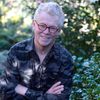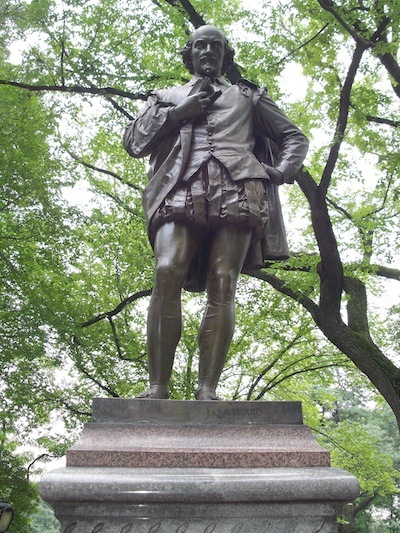
I came up the well-worn cement stairs from the "A" Train at the West Fourth Street station, to a gloriously clear New York September afternoon. There was very little traffic, quite unusual for this time of day and, especially, for this street -- the Avenue of the Americas (or Sixth Avenue) -- which is usually clogged with angry cars piloted by angry drivers. I had come to this corner frequently in the past, to watch black men play an amazingly accomplished brand of basketball on a fenced public cement court a block from the subway entrance. It's a famous place. The great Connie Hawkins had played here from time to time before moving on to the NBA. The basketball in general on this court is just a notch below the professional level.
But today there was no basketball. Rather a blue sky of pristine depth and brilliance, clear air and many green-leafed trees, and an almost noiseless gathering of pedestrians -- Greenwich Village people with many rings stuck into lips and noses, green hair, army boots, men arm in arm with men, women with women -- standing on the curbs, at every street corner, in doorways everywhere, all of them shading their eyes, many of them weeping, looking to the south.
The World Trade Center towers had imploded that morning, to the ground.
I had been on my way to JFK, to catch a flight back to San Francisco. The "A" train comes up above ground a few stops before the Aqueduct Race Course, and I had seen the two huge plumes of smoke. Not being able to judge the distances, I had thought that they were much smaller and much closer to the train than in fact was the case. So I had wondered to myself why the air pollution control people hadn't done anything about that factory over there and the dirty smoke that was gushing from its stacks. When I arrived at the United Airlines desk at JFK, there were no passengers. A very calm East Indian man in a red coat, white shirt and dark blue tie, an employee of the airline, informed me in a quiet, rather terrified voice -- as though we were intimate friends -- that the Trade Center buildings had been struck by airliners.
Now, coming up from the subway station, I looked for the smoke and couldn't see it. I was facing in the wrong direction. Crossing Sixth Avenue, I came out from behind the apartment buildings that had obscured the view to the south, and saw the cloud, finally, climbing into the air like the smoke in films I had seen as a child of atomic blasts...smoke filled with earth, tons of debris and fluttering papers. It rose up to the heavens, yellow-white and gargantuan, in furious, boiling flumes, angry and incomprehensible.
I stayed with friends for the next several nights, who very kindly offered me their guest bedroom. They live near Lincoln Center, and the morning after the attack on the Trade Center, I went out for a walk toward Central Park. In years previous, I had frequently stopped at the Chez Madeleine creperie, a kiosk at the Columbus Circle entrance to the park, at the foot of the Battleship Maine monument. You could order a crepe there that was filled with apple and banana... a true sweet wonder. I had had several during the years I had lived in Manhattan, with large caffe lattes.
To get there on this morning, I walked down Amsterdam Avenue toward the offices of the American Red Cross building, which is located very near the Fiorello LaGuardia School for the Performing Arts. As I approached the Red Cross, I saw a few thousand people lined up on the sidewalk around the building, waiting to donate blood. There were hundreds of volunteers as well trying to organize the crowd, and the scene was one of concerned, cooperative and even humorous chaos. Many of the volunteers were students from the performing arts school, kids with Red Cross T-shirts who were offering bottles of water, doughnuts, sandwiches and coffee to the citizens on line. In the few minutes that I stood there talking to blood donors, what appeared to be several hundred more donors gathered in the line behind us. There was shouting, encouragement, brave-sounding pronouncements about seeking revenge for the attack, equally brave professions of peace and equanimity.
The television networks had been making a big deal of the humanity of New Yorkers, the outpouring of sympathy and grief on the part of this usually hard-boiled populace. I realized, as I stood there talking with people, that that presentation was entirely accurate.
Across the street, there was a fire station in front of which lay a phalanx of flowers, flowers of every kind that appeared from this distance as smears of lush color brightening the gray sidewalk, votive candles burning in glass jars, and many hand-written notes and letters that had been taped to the cement facade of the station itself. A number of firefighters stood about before the station talking with people, dressed in the canvas and rubber outfit of their profession, with the odd, curved, high-crowned helmet that so distinguishes them. They were exhausted, dirty with white dust and watered-down scum, and very chagrined. When I crossed the street to speak with a few of them, I learned that eleven of the men from this station had died the morning before, when the first tower had collapsed.
A half-hour later -- astonished and beaten down by this revelation -- I carried my crepe to the statue of William Shakespeare.
There is a lot of ardent sculpture in Central Park, some of the very worst of it in The Mall that parallels Fifth Avenue from 59th Street up to the 72nd Street traverse. "Ardent" in the sense of the sculptor's wish to lay bare his seething post-Romantic emotions. A statue of Robert Burns looks off into the distance, his robes flowing about him like leaden lava. Another of Fitz-Greene Halleck also looks off into the distance, a pen in his right hand hovering over the ground, the hand hanging down from his chair as though it is waiting for some divine intervention to make it move. Fitz-Greene was as well known as Burns in his own lifetime, and actually wrote about Burns:
Such graves as his are pilgrim shrines,
Shrines to no code or creed confined--
The Delphian vales, the Palestines,
The Meccas of the mind.
Fitz-Greene knew about where he lived, referring in a poem called "Alnwick Castle" to "this bank-note world." It was, after all, New York City and he was John Jacob Astor's secretary.
But a look of transfixed, clueless puzzlement wears on the face of Fitz-Greene's statue. I worry, looking at him, that the ink will dribble from the quill in his hand to the earth below, so that when the moment of light finally does flash into Fitz-Greene's mind, he won't be able to write it down because the quill will be dry.
But then there's the statue of Shakespeare.
This one is a marvel. The statue is by John Quincy Adams Ward, and Will stands casually on a marble pedestal in Elizabethan attire (short ballooning pantaloons, long stockings, a pair of leather shoes with buckles, a shirt with floppy sleeves that is open at the throat, and a vest, perhaps of leather. Also, a cape hangs down his back from his shoulders.) He holds a book in his right hand, clutched to his chest, and, instead of looking into the distance, he's looking down at an angle, in a moment's thought, maybe a little despondently.
The other statues on The Mall strive for transfixed inspiration. But this is a major sculpture suffering a minor distraction. Shakespeare is looking for the homely moment in which to find his metaphor. He is seeking the proper word, the proper collaboration of words. He's quizzical and self-involved, caught for the moment in private.
You can tell he's an actor because a lower portion of the cape is draped over his right arm, the arm holding the book. It's a jaunty thing he's doing there, a gesture to elan and showmanship.
But this man is also a working writer. He has little interest in having some flash of inspiration flood his eyes. Rather he is interested in finding the right few words for his valiant, black military hero's increasing worry that this world is not a safe place for those who would protect good people. Simple as that. Will's got a problem -- how to get Othello from here to there, how to get his actor to act -- and he's trying to figure it out.
I looked up at him for a moment, thanking him for all the things he had written. Then I turned my back on him to look toward the south once more. The smoke still rose, still boiling, the dead still lying in their thousands, scattered into pieces beneath the debris downtown. There is not an actor in the world that could effectively play a part in such a scene, because there is no illusion in the scene. No play-act. No dramatic gesture. And no writer could ever convey the pain that pushed that cloud up through the blue sky.

